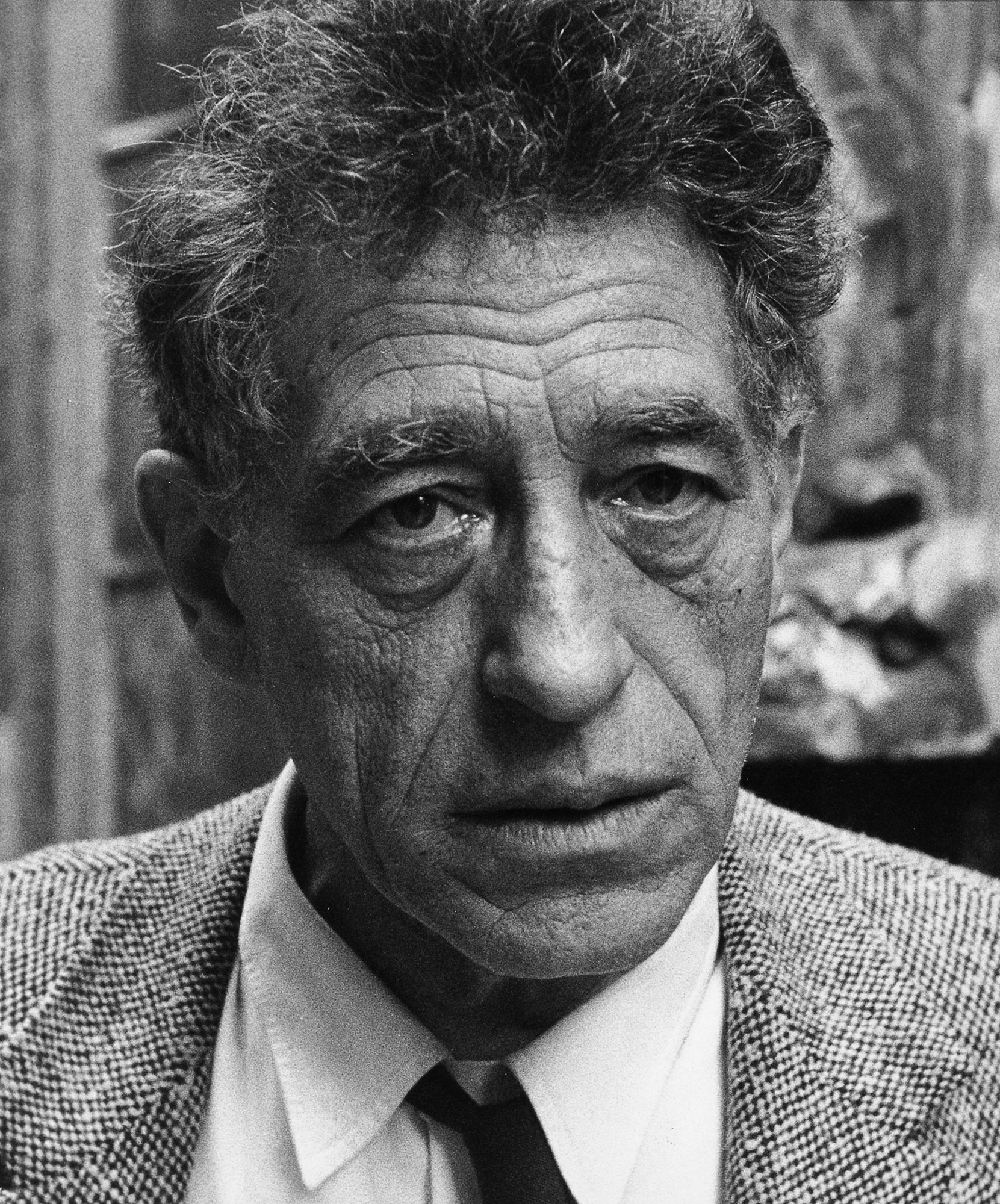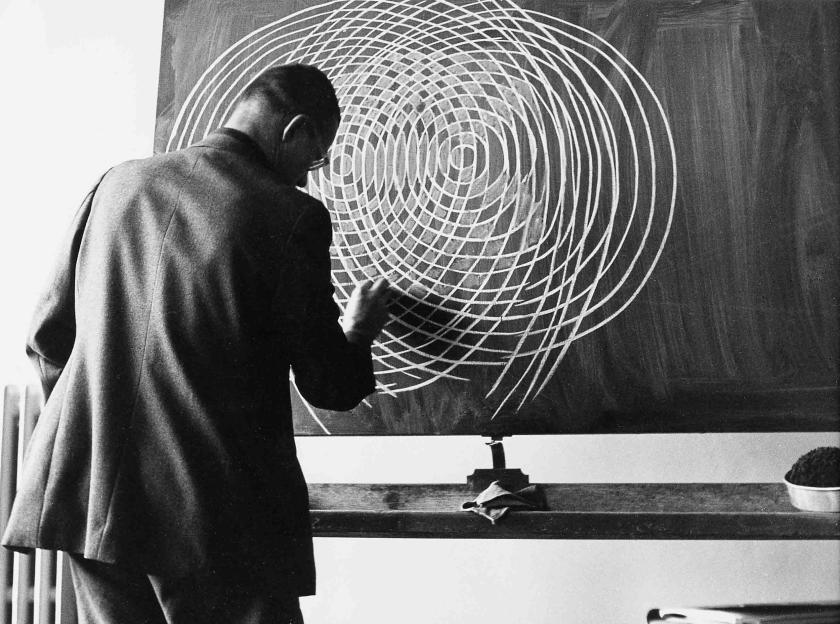With a troubled gaze and a lived-in face, the portrait of artist Alberto Giacometti on a withdrawn Swiss banknote is strange currency indeed. One need only think of the confidence and pomp with which national heroes gaze at us from Great British cash. Yet Giacometti is in the zone here, retaining the expression of weary humanity with which one imagines he probes the appearance of his sitters. Between 1998 and 2016, at least, the Swiss national bank was self-assured enough to accommodate real character and a bit of personality on its 100 Franc note.
This image, itself an arguable masterpiece, was created by one of Switzerland’s most illustrious photographers, Ernst Scheidegger, now the subject of a major national exhibition in the Museo d’arte della Svizzera italiana (MASI). The Museum of Swiss-Italian art in Lugano, surrounded by Swiss-Italian mountains, has called the show Eye to Eye. It allows one to level the gaze with a number of prominent artists from the 20th century, to see their studios, and to spy them at work (main picture: Max Bill teaching Theory of Forms at the Kunstgewerbeschule in Zurich, 1946, by Ernst Scheidegger).

While these portraits of great artists-in-action may imply Scheidegger’s role was straightforward and secondary, his construction of public images for his colleagues does reflect a deft and unobtrusive rapport. This was at times so powerful that one of his friends, the otherwise satisfied customer Giacometti, would later struggle to find a fresh perspective by someone different. He writes to his dealer in 1963, asking for the services of the photographer Herbert Matter.
For better or for worse, Scheidegger’s vision has stuck. He finds Giacometti so absorbed in his deeply serious work that the artist seems unaware of the lens, and he documents the studio as a dusty, untidy space filled with unfinished works. One shot features the artist walking through the door with motion blur that heightens the mood of reportage. Another is shot from, surely, a ladder - to get an aerial view. We may infer that Scheidegger, who was a Magnum reporter after all, was so embedded with his assignment that he got to his client’s Paris address before him, even climbing to the rafters, to stake out his quarry.
These portraits of Giacometti (pictured right) are displayed alongside one of his trademark pinched and diminishing sculptures together with an intense reverse portrait of Scheidegger, in which the photographer looks affronted to meet with this painterly scrutiny. The result is assiduously worked and alive with wiry lines. But one does feel as if, despite their longstanding friendship, the artist has evoked the photographer’s existential solitude rather than his collaborative qualities. Genius is perhaps always lonely.
Scheidegger’s quietly attentive camera also gained him access to many of Giacometti’s peers. Marc Chagall, Joan Miró, and Salvador Dalí all appear. The photographer’s trick, if one can call it that, has been to appreciate the artwork and capture his subjects while oblivious. He usually catches artists while fully-absorbed with their easel or off-guard in conversation. Portraits here of Miró are particularly vital as a result of the photographer’s casual presence. A work showing the Catalan surrealist in his studio in Barcelona, c. 1952/53, reveals a cheerful worker, happy to be caught in the act of improvising pictographic forms on canvas. Visitors will no doubt enjoy an opportunity to put faces to names and that is foremost among the pleasures of this show. But the many supporting early works offer a pleasing contrast with the frozen moments of VIP access to the European avant-garde. These consist of a collection of square-format studies of painterly photographic subjects, because in the early years of his career, as a skilled photojournalist, Scheidegger found inspiration in the circus, in fun fairs, in peasantry and street urchins.
Scenes from passing life are framed stylistically as complete pictures, over and again. There are Children on the beach in Southern France, c. 1950, visible against a parcel of silver sky with walls of a dark alley closing in on both sides. There is a likely cleric whose black cassock is matched by the early morning shadows of Place du Maroc in Paris, c. 1950. The passing of time is built in. Scheidegger’s Billboard, Milan, c.1948, is certainly dated. Italian locals appear here dwarfed by a vast ad hoarding in which the lead brand, Cinzano, has endured more than the horse drawn carriages beneath it.
 Modernity, which often took the form of advertising and modern art, was to sweep aside the rural and the traditional, and Scheidegger had a foot in both camps. Not only a photographer; he was a painter and moreover a graphic designer. He was tasked to design a Europe-wide travelling exhibition to promote the huge postwar aid programme known as the Marshall Plan. HIs photograph of this, Entrance to Europa baut, c.1950, was taken in a pivotal year between old and new worlds. The date appears in a modernist typeface beneath the sail-like canopy of a futuristic pavilion. Parisians queue to file inside in old fashioned clothes. In this presentation of a photographic career one notes that photos of a traditional way of life give way to photos of modern art iconoclasts.
Modernity, which often took the form of advertising and modern art, was to sweep aside the rural and the traditional, and Scheidegger had a foot in both camps. Not only a photographer; he was a painter and moreover a graphic designer. He was tasked to design a Europe-wide travelling exhibition to promote the huge postwar aid programme known as the Marshall Plan. HIs photograph of this, Entrance to Europa baut, c.1950, was taken in a pivotal year between old and new worlds. The date appears in a modernist typeface beneath the sail-like canopy of a futuristic pavilion. Parisians queue to file inside in old fashioned clothes. In this presentation of a photographic career one notes that photos of a traditional way of life give way to photos of modern art iconoclasts.
My favourite portrait in Lugano was of an artiste rather than an artist. Clown awaiting his cue at circus Knies, c.1949 (pictured above left), shows a down-at-the-mouth funnyman with an inflatable ball on each knee, readying himself for a performance in the big top in Zurich. Scheidegger bestows on his comic sitter the dignity of any other human being who does a skilled and difficult job. Strange to think this photo contains the seeds of Scheidegger’s somewhat glum shots of Giacometti.
With portraits of clowns, escapologists and showgirls alongside those of avant garde painters, sculptors, and intellectuals, Eye to Eye is a riveting clash of high and low art, of modernity and tradition, and of circus and its unlikely corollary, the studio.










![SEX MONEY RACE RELIGION [2016] by Gilbert and George. Installation shot of Gilbert & George 21ST CENTURY PICTURES Hayward Gallery](/sites/default/files/styles/thumbnail_125_x_125_/public/mastimages/Gilbert%20%26%20George_%2021ST%20CENTURY%20PICTURES.%20SEX%20MONEY%20RACE%20RELIGION%20%5B2016%5D.%20Photo_%20Mark%20Blower.%20Courtesy%20of%20the%20Gilbert%20%26%20George%20and%20the%20Hayward%20Gallery._0.jpg?itok=3oW-Y84i)




Add comment